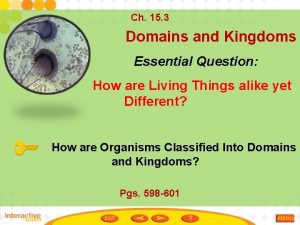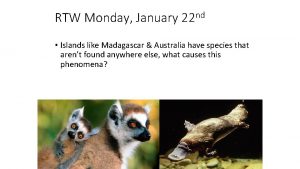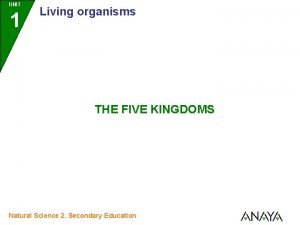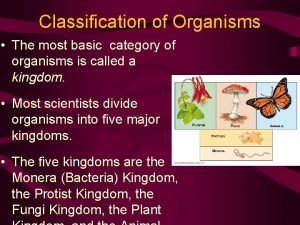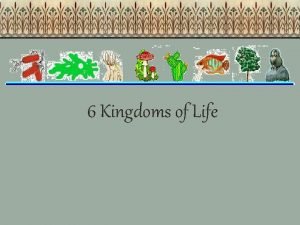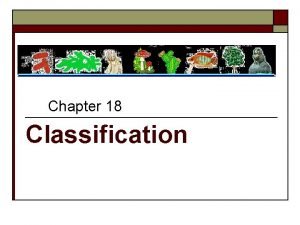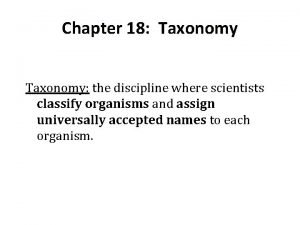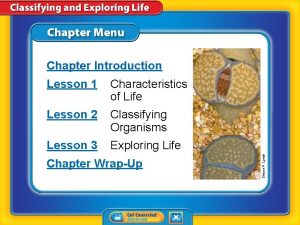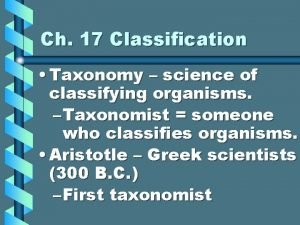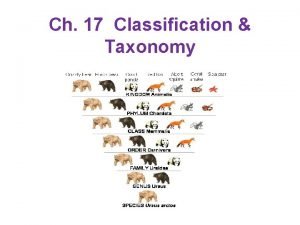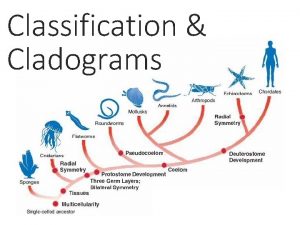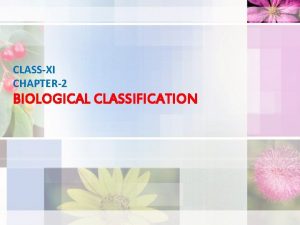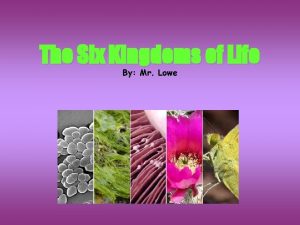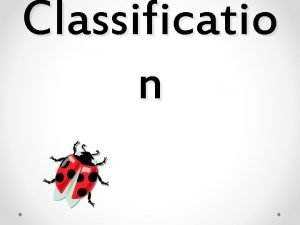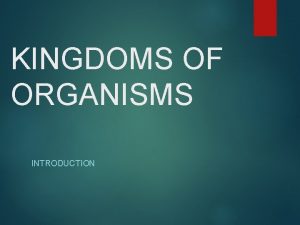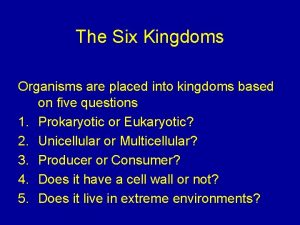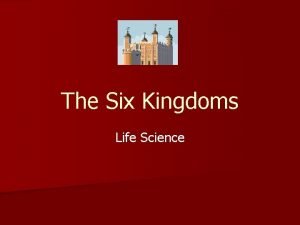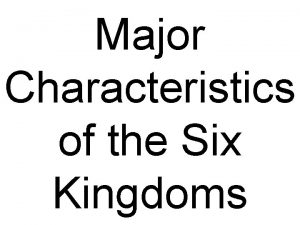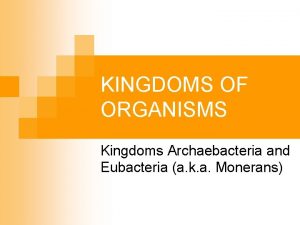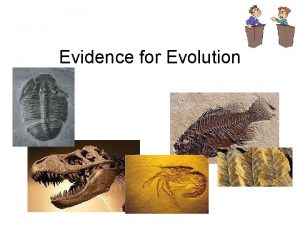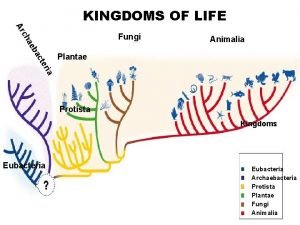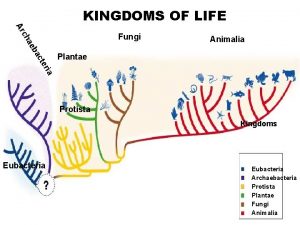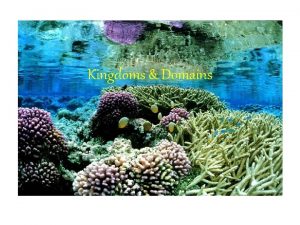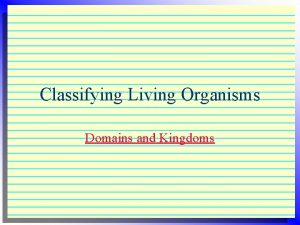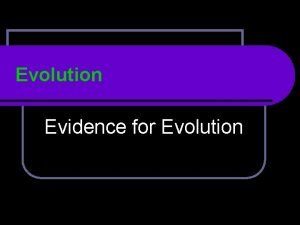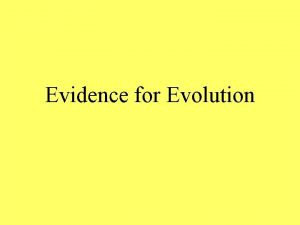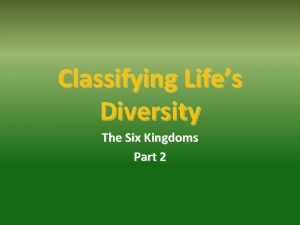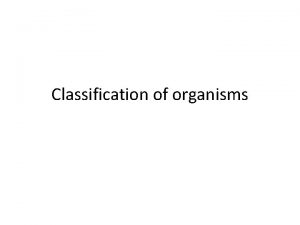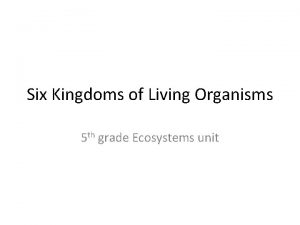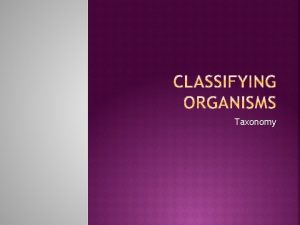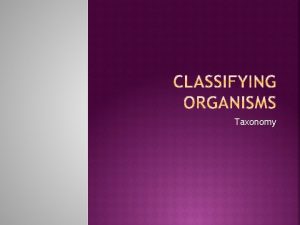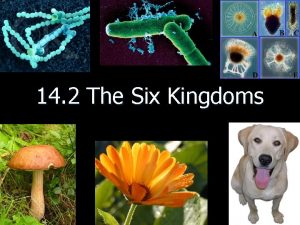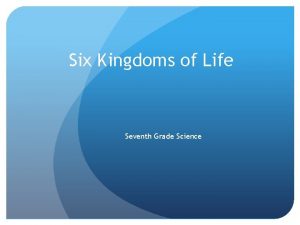Classifying Organisms The Six Kingdoms Evidence for Evolution
























- Slides: 24

Classifying Organisms The Six Kingdoms

Evidence for Evolution u Fossil evidence u Similarities in Body structure – how bones are arranged. Similar structure are called homologus u Similarities in early development (before birth) – chicken, turtle, rat u Similarities in DNA (sequence of nitrogen bases) u Scientist combine evidence to show relationships between organisms – use a diagram called a branching tree.

u Classification = the process of grouping things based on their similarities. u Biologists use it to organize living things into groups for easier study. u Evolutionary theory assumes that similar organisms in a group evolved from a common ancestor. u But, sometimes the system is used only for identification.

Man’s Early Systems of Classification: Aristotle (Greek in 4 th century B. C. ) u Three groups (Fly, Swim, Walk) u With such a system how would you classify a duck? u

Current System: u Linnaeus (1750’s) u Used a two-part naming system from Latin. (Dog = Canis familiaris) Binomial Nomenclature = a two-part name 1. Genus = first part of the name (Capitalized) (Groups similar, related organisms) 2. Species = second part of the name. (Lowercase) (Groups similar organisms that can mate and produce fertile offspring) u

Binomial Nomenclature

Modern Study of Classification is called systematics u Mostly DNA and molecular biology are used to identify relationships u The closer the DNA sequences, the more closely related the organisms u New discoveries might cause changes in classification system

Land Classification Examples Worlds (Earth, Mars, Venus…) Continents (North American, Europe…) Countries (America, Canada, Spain…) States (Louisiana, Texas, Utah, …) Parishes (Counties) Cities (Slidell, Dallas, …) Neighborhoods (…) Streets (…) Houses (…)

Classifying Your Own House Worlds (Earth) Continents (North American) Countries (America) States (California) Parishes (Los Angeles County) Cities (Diamond Bar) Neighborhoods (? ? …) Streets ( ? ? ? …) House (? ? ? …)

Seven Levels of Biological Classification: Kingdom – Phylum – Class – Order – Family – Genus – Species – “Kingdom” is the biggest and broadest. Each kingdom contains phyla – each phyla contains classes, etc. The more levels that two organisms share, the more characteristics they have in common.

Try this to remember the first letters of the levels: Kings Play Chess On Fancy Green Squares

Classification of the Lion u u u u Kingdom: Animalia (includes all animals) Phylum: Chordata (includes all vertebrate animals, as well as some other more primitive ones) Class: Mammalia (includes all mammals) Order: Carnivora (includes carnivorous mammals, from bears to raccoons to harbor seals) Family: Felidae (includes all cats) Genus: Panthera (includes the great roaring cats: lions, tigers, jaguars, and leopards) Species: leo (lions!)

Classification of Humans u Kingdom: Animalia Phylum: Chordata Class: Mammalia Order: Primates Family: Hominidae Genus: Homo Species: sapiens u Homo means “self” or “same”, meaning “the same as me” — which, for you, means “human”. Sapiens means “wise”. Therefore, Homo sapiens means “Wise human”

Section 6. 2 The Six Kingdoms Linnaeus only used two kingdoms (Plants and Animals) Until recently, scientists used a five kingdom system that combines #’s 1 & 2 below. Six Kingdoms are now the standard: 1. Archaebacteria 2. Eubacteria 3. Protists 4. Fungi 5. Plants 6. Animals

1. Archaebacteria (Unicellular) - prokaryotes = genetic material is not in a nucleus * Means “ancient bacteria”, since evolutionists believe they evolved first. * Some live in extreme environments, like very hot water near lava. * Some are autotrophs, and some are heterotrophs

2. Eubacteria (Unicellular prokaryotes) “True Bacteria” * Similar to archaebacteria, but their chemical makeup is different. * Live all over the world, including your body. * Most are harmless, and some are very useful.

3. Protists (“Odds and ends” category; many types. ) * Some are unicellular like the paramecium, yet others are multicellular (seaweed). * They are all eukaryotes (have a nucleus around their genetic material).

4. Fungi (Mushrooms, molds, mildew, yeast) * Most are multicellular eukaryotes. * A few like yeast are unicellular eukaryotes. * All are heterotrophs, most feed on decaying organisms.

5. Plants * All are multicellular eukaryotes. * All are autotrophs.

6. Animals * All are multicellular eukaryotes. * And all are heterotrophs.

How can you identify an organism you find? Taxonomy = the scientific study of how living things are classified. Field Guide = book with pictures and descriptions of organisms and characteristics Taxonomic Key = series of paired statements describing characteristics of organisms



A taxonomic key contains a series of paired statements that help you identify an organism
 Six kingdoms
Six kingdoms How are organisms classified into domains and kingdoms
How are organisms classified into domains and kingdoms Which kingdoms have photosynthetic organisms? *
Which kingdoms have photosynthetic organisms? * Unit 1
Unit 1 Which kingdoms contain organisms that are multicellular?
Which kingdoms contain organisms that are multicellular? 3 domains and 6 kingdoms chart
3 domains and 6 kingdoms chart Human taxonomy
Human taxonomy Lesson 2 classifying organisms
Lesson 2 classifying organisms Kingdom animalia cladogram
Kingdom animalia cladogram The scientific discipline of classifying organisms
The scientific discipline of classifying organisms Classifying and exploring life lesson 2 answers
Classifying and exploring life lesson 2 answers In the discipline of taxonomy what is a domain
In the discipline of taxonomy what is a domain Discipline of classifying and naming organisms
Discipline of classifying and naming organisms Classifying organisms worksheet
Classifying organisms worksheet Discipline of classifying and naming organisms
Discipline of classifying and naming organisms Classification groups in order
Classification groups in order Lesson outline classifying organisms
Lesson outline classifying organisms Canis latrans classification
Canis latrans classification Member of the same species
Member of the same species Organisms
Organisms Cladogram of 6 kingdoms
Cladogram of 6 kingdoms Characteristics of the six kingdoms
Characteristics of the six kingdoms Six kingdoms worksheet
Six kingdoms worksheet What are the six kingdoms of life?
What are the six kingdoms of life? Six kingdoms of classification chart
Six kingdoms of classification chart

